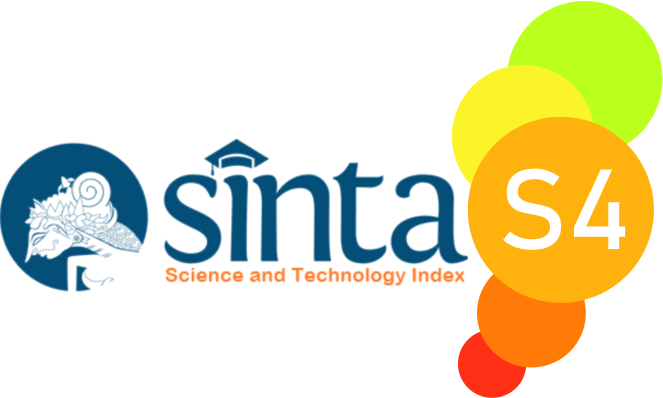The Application of Jigsaw Tasks by Using Scrambled Sentences in Teaching Reading Descriptive Text
Abstract
This study aims to know the implementation of Jigsaw Tasks by using Scrambled Sentences in teaching reading descriptive text and its strengths and weaknesses. This is qualitative research. The data are collected using observation and interviews. Meanwhile, the data analysis uses three steps: reduction data, display data, and data verification. The results show that in the implementation of jigsaw tasks by using scrambled sentences, the students pay attention and listen to the explanation of the teacher during the teaching-learning process. They rearrange the jumble sentences card based on the pictures by adhering to the flannel board. The advantages are it could increase the student’s vocabulary mastery, and the jigsaw task technique with scramble sentences could motivate the students to understand the descriptive text and make the students focus on the material given. Besides, the students are active, enthusiastic, and enjoy learning to read descriptive text by using jigsaw tasks with scrambled sentences The disadvantages are the students make noise. Hence, his method is recommended for all teachers to use for teaching reading descriptive text and for future research to conduct the same research but in different fields.
References
Alghasab, M., Hardman, J., & Handley, Z. (2019). Teacher-student interaction on wikis: Fostering collaborative learning and writing. Learning, Culture and Social Interaction, 21(August 2018), 10–20. https://doi.org/10.1016/j.lcsi.2018.12.002
Chan, S. C. H., Wan, J. C. L., & Ko, S. (2019). Interactivity, active collaborative learning, and learning performance: The moderating role of perceived fun by using personal response systems. International Journal of Management Education, 17(1), 94–102. https://doi.org/10.1016/j.ijme.2018.12.004
Chang, W. L., & Benson, V. (2020). Jigsaw teaching method for collaboration on cloud platforms. Innovations in Education and Teaching International, 00(00), 1–13. https://doi.org/10.1080/14703297.2020.1792332
Chen, C. M., & Kuo, C. H. (2019). An optimized group formation scheme to promote collaborative problem-based learning. Computers and Education, 133(64), 94–115. https://doi.org/10.1016/j.compedu.2019.01.011
Gaias, L. M., Lindstrom Johnson, S., Bottiani, J. H., Debnam, K. J., & Bradshaw, C. P. (2019). Examining teachers’ classroom management profiles: Incorporating a focus on culturally responsive practice. Journal of School Psychology, 76(June), 124–139. https://doi.org/10.1016/j.jsp.2019.07.017
Halimah, L., & Sukmayadi, V. (2019). The Role of" Jigsaw" Method in Enhancing Indonesian Prospective Teachers’ Pedagogical Knowledge and Communication Skill. International Journal of Instruction, 12(2), 289–304.
Husna, A. (2022). An Analsysis Of The Students’ Perception Ongoogle Classroom For Learning English. Journey: Journal of English Language and Pedagogy, 5, 191–204.
Jones, K. F., & Schwartz, A. W. (2018). Jigsaw Education Technique to Teach Geriatrics Palliative Care Principles to an Interprofessional Team. Journal of Pain and Symptom Management, 56(6), e86. https://doi.org/10.1016/j.jpainsymman.2018.10.304
Karacop, A. (2017). The Effects of Using Jigsaw Method Based on Cooperative Learning Model in the Undergraduate Science Laboratory Practices. Universal Journal of Educational Research, 5(3), 420–434.
Li, Z., Peng, C., Tan, W., & Li, L. (2021). An effective chaos-based image encryption scheme using imitating jigsaw method. Complexity, 2021, 1–18.
Mora, H., Signes-Pont, M. T., Fuster-Guilló, A., & Pertegal-Felices, M. L. (2020). A collaborative working model for enhancing the learning process of science & engineering students. Computers in Human Behavior, 103(October 2018), 140–150. https://doi.org/10.1016/j.chb.2019.09.008
Nalls, A. J., & Wickerd, G. (2022). The Jigsaw Method: Reviving a Powerful Positive Intervention. Journal of Applied School Psychology, 1–17.
Nurbianta, N., & Dahlia, H. (2018). The Effectiveness of Jigsaw Method in Improving Students Reading Comprehension. ETERNAL (English Teaching Journal), 9(1), 70–86. https://doi.org/10.26877/eternal.v9i1.2416
Rahmasari, B. S. (2017). The application of cooperative script method in teaching reading of narrative text at the first semester students of Universitas PGRI Madiun. Linguista: Jurnal Ilmiah Bahasa, Sastra, Dan Pembelajarannya, 1(2), 127. https://doi.org/10.25273/linguista.v1i2.1983
Rahmasari, B. S. (2022). Big Book: An Attractive Way to Comprehend Reading Text for Young Learners. Journal of Teaching and Learning in Elementary Education (Jtlee), 5(1), 48–55. https://doi.org/10.33578/jtlee.v5i1.7905
Sugiyono, P. D. (2015). Metode penelitian pendidikan (pendekatan kuantitatif, kualitatif, dan R&D)(Vol. 21). Bandung, Indonesia: Alfabeta, CV.
Copyright (c) 2023 Brigitta Septarini Rahmasari, Andi Nurul Aini

This work is licensed under a Creative Commons Attribution-ShareAlike 4.0 International License.

Journey: Journal of English Language and Pedagogy by http://ejurnal.budiutomomalang.ac.id/index.php/journey/index is licensed under a Creative Commons Attribution-ShareAlike 4.0 International License.






